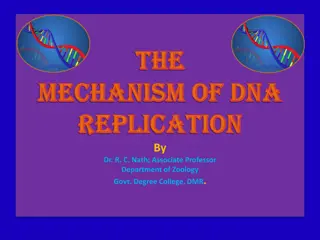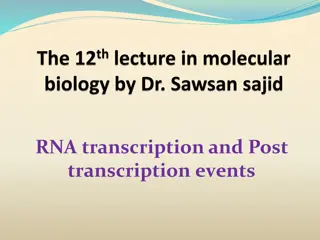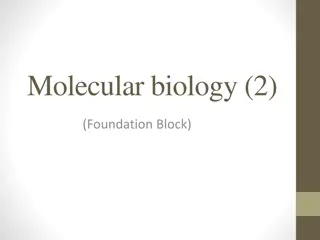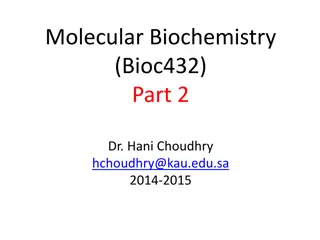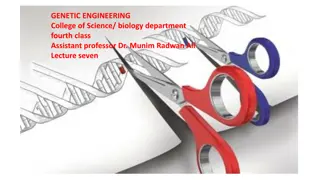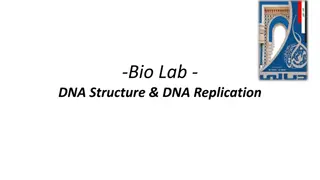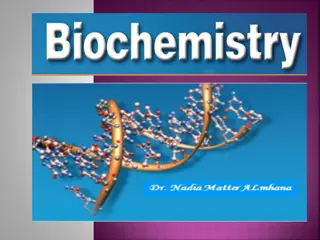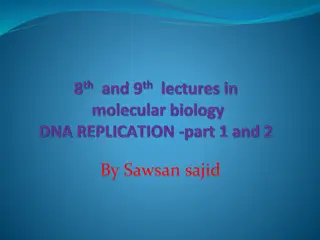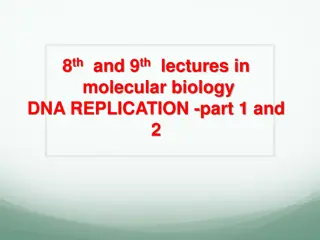Understanding DNA Replication Process: Insights and Mechanisms
DNA replication is a crucial biological process where identical copies of DNA molecules are produced for cell division. Initiated by specific proteins, it involves stages like initiation, elongation, and termination. Enzymes like helicases and DNA polymerase play key roles in forming replication forks. This process ensures genetic information is accurately passed on to offspring cells, contributing to biological inheritance across living organisms.
Download Presentation

Please find below an Image/Link to download the presentation.
The content on the website is provided AS IS for your information and personal use only. It may not be sold, licensed, or shared on other websites without obtaining consent from the author. Download presentation by click this link. If you encounter any issues during the download, it is possible that the publisher has removed the file from their server.
E N D
Presentation Transcript
8thand 9thlectures in molecular biology DNA REPLICATION -part 1 and 2 By Senior professor Dr Sawsan sajid Dr Nadal Abdulameer Ali
What is DNA replication ??? Before each cell division, new copies must be made of each of the many molecules that form the cell, including the duplication of all DNA molecules. DNA replication is the name given to this duplication process, which enables an organism s genetic information its genes to be passed to the two daughter cells created when a cell divides. DNA replication is the process of producing two identical copies from one original DNA molecule. This biological process occurs in all living organisms . It is the basis for biological inheritance. DNA is composed of two strands and each strand of the original DNA molecule serves as template for the production of the complementary strand, a process referred to as semiconservative replication.
the process followed by proofreading or error-checking mechanisms to ensure correct reading to the genetic code,. like all biological polymerization processes(Transcription and Translation), the process involve 3 stages : 1- Initiation 2-Elongation and 3- Termination. Early studies of DNA replication mainly depend on the observation of Meselson and Stahl(1958) ,the British biochemist John Carnis (1963) and the Japanese scientist Reiji Okazaki (1968
Steps of DNA replication 1- Initiation: the process require replictor and intiator protein(DnaA protein ). For a cell to divide, it must first replicate its DNA.This process is initiated at particular points in the DNA, known as replicator (200-300 bp) which contain specific area called "origin of replication ori c or Dna A box) ", which will opened by initiator proteins. In E. coli this protein is called DnaA protein ; in yeast, is called origin recognition complex. Sequences opened by initiator proteins tend to be "AT-rich" (rich in adenine and thymine bases), because A-T base pairs have two hydrogen bonds (rather than the three bond in a C-G pair).
Replication fork The replication fork is a structure that forms during DNA replication .Many enzymes are involved in the DNA replication fork in order to stabilize initiation step . helicases, which break the hydrogen bonds holding the two DNA strands together. The resulting structure has two branching "prongs", each one made up of a single strand of DNA. These two strands serve as the template for the leading and lagging strands, which will be created as DNA polymerase matches complementary nucleotides to the templates; the templates may be properly referred to as the leading strand template and the lagging strand templates. SSBPs also required here Single-Strand Binding (SSB) Proteins Bind to ssDNA and prevent the DNA double helix from re-annealing after DNA helicase unwinds it thus maintaining the strand separation
Once the origin has been recognized ,the initiators proteins (DnaA protein ) start forming the pre- replication complex, which unwind the double- stranded DNA . All known DNA replication systems require a free 3' hydroxyl group before synthesis can be initiated . use (RNApolymerase) to synthesize a short RNA primer(10-20 bp) with a free 3 OH group which is subsequently elongated by a DNA polymerase in this mechanism, a primase enzyme
Prokaryotic and eukaryotic DNA replication is bidirectional The experiment of John Cairns in 1963 demonstrated by autoradiography that the DNA of Escherichia coli is a single circular not linear molecule that is replicated from a point or moving locus forming the ( replicating fork) at which both new DNA strands are being synthesized. The movement of this fork is bidirectional in another world there are two moving forks, traveling in opposite directions around the chromosome forming theta shape (the Greek letter) which look like a bubble . it start from one point called ori c (origin of replication) and replication continue till reaching the opposite direction in one point called Ter i( from terminus). Also the shape is called the (A-butter fly replication) (
Replication in eukaryotic cell start from more than one ori c(each 300bp there is oric ) so multiple replication bubbles will form thus replication here is faster than prokaryotic cell
2- Elongation step DNA is always synthesized in the 5' to 3' direction. DNA Polymerase is an enzyme who synthesis new DNA strands Even with the DNA template exposed, new DNA cannot be synthesized until a primer is constructed. Recall that all known DNA polymerases require a primer with a free 3 -hydroxyl group for DNA synthesis. How is this primer formed? An important clue came from the observation that RNA synthesis is essential for the initiation of DNA synthesis. In fact, RNA primes the synthesis of DNA by a specialized RNA polymerase called primase. Primase synthesizes a short stretch of RNA (~5 nucleotides) that is complementary to one of the template DNA strands. The primer is RNA rather than DNA because DNA polymerases cannot start chains de novo
A new DNA strand is always synthesized in a 5 to 3 manner, thus the replication of both the strands goes in two different ways. Since the leading and lagging strand templates are oriented in opposite directions at the replication fork, a major issue is how to achieve synthesis of nascent (new) lagging strand DNA, whose direction of synthesis is opposite to the direction of the growing replication fork.
1- Leading strand DNA polymerase III begins the synthesis of the leading strand by using the RNA primer formed by primase ( from 5 -3 direction or the same direction as the replication fork movement) The leading strand is synthesized continuously by polymerase III, which does not release the template until replication has been completed. This strand is formed as nucleotides are continuously added to the 3 end of the strand after polymerase reads the original DNA template . Only one primer will require here . no Okazaki fragment are formed.
2- lagging strand: However, all known DNA polymerases synthesize DNA in the 5 3 direction but not in the 3 5 direction. How then does one of the daughter( lagging ) DNA strands appear to grow in the 3 5 direction? A lagging strand is the strand which is synthesized in the 3 -5 direction or opposite direction as to the movement of the replication fork. It grows or is synthesized away from the fork. This why it is discontinuous; it is synthesized in short, separated segments. On the lagging strand template, a primase "reads" the template DNA and initiates synthesis of a short complementary RNA primer. A DNA polymerase III extends the primed segments, forming Okazaki fragments. DNA polymerase will add nucleotides in the 5' to 3' direction;
More than one primer will be necessary here and it will be removed later by the exonuclease activity of DNA polymerase (I) which will fill the gap between two adjacent Okazaki fragments. the final binding will done by the activity of ligase enzyme who will add a 3 5 phospho diester bond continuously ; this is the reason why the synthesis of the lagging strand is more complicated than the leading strand. DNA polymerase molecules are required for polymerization the two strands which run together in the same machine binding together but still the replication happened in opposite direction The polymerase involved in leading strand synthesis is DNA polymerase III(DNA Pol III) in prokaryotes and presumably Pol in yeasts. In human cells the leading and lagging strands are synthesized by Pol and Pol , respectively, within the nucleus and Pol in the mitochondria
3-Termination 1-Termination requires that the progress of the DNA replication fork must stop or be blocked. Termination at a specific locus, when it occurs, involves the interaction between two components: (1) a termination site sequence in the DNA, and (2) a protein which binds to this sequence to physically stop DNA replication. In various bacterial species, this is named the DNA replication terminus site-binding protein, or Ter protein. 2-Because bacteria have circular chromosomes, termination of replication occurs when the two replication forks meet each other on the opposite end of the parental chromosome . As a result, the replication forks are constrained to always meet within the termination region of the chromosome.
3-Removes the primer (RNA fragments), by DNA polymerase I by 5'-3' exonuclease activity of polymerase I, and replaces the RNA nucleotides with DNA nucleotides. and fill the gaps. 4- When this is complete, a single nick on the leading strand and several nicks on the lagging strand can be found. 5- Ligase works to fill these nicks in, thus completing the newly replicated DNA molecule . 6- Topoisomerase IV will : separate the two complete daughter chromosome in to two chromosome To form a continuous lagging strand of DNA, the RNA primers must eventually be removed from the Okazaki fragments and replaced with DNA. In E. coli, RNA primers are removed by the combined action of RNase H, an enzyme that degrades the RNA strand of RNA-DNA hybrids, and polymerase I.
Termination in Eukaryotic cell Primer removal in eukaryotes is performed by RNase I that remove all the primer leaving only one nucleotide in the junction between 2 nucleotide and the remained one will removed by FenI enzyme. Eukaryote cell initiate DNA replication at multiple points in the chromosome, so replication forks meet and terminate at many points in the chromosome; these are not known to be regulated in any particular way. Because eukaryotes have linear chromosomes, DNA replication is unable to reach the very end of the chromosomes, but ends at the Telomere region of repetitive DNA close to the end.
This shortens the telomere of the daughter DNA strand. Shortening of the telomeres is a normal process in Somatic cells. As a result, cells can only divide a certain number of times before the DNA loss prevents further division. Within the Germ cell line, which passes DNA to the next generation, Telomerase extends the repetitive sequences of the telomere region to prevent degradation. Telomerase can become mistakenly active in somatic cells, sometimes leading to Cancer formation. in the end of the replication the DNA will warp around the basic hiatons to form the chromatin
DNA Helicase Also known as helix destabilizing enzyme cases formation of Replication Fork due to broken hydrogen bonds DNA Polymerase Builds a new duplex DNA strand by adding nucleotides in the 5' to 3' direction. performs proof-reading and error correction. DNA clamp: A protein (unit from polymerase which prevents DNA polymerase III from dissociating from the DNA parent strand. Single-Strand Binding (SSB) Proteins Bind to ssDNA and prevent the DNA double helix from re-annealing after DNA helicase unwinds it thus maintaining the strand separation
DNA Gyrase (and Topoisomerase IV) ; this is a specific type of topisomerase II convert relaxed form to super coiled DNA Ligase Re-anneals the semi-conservative strands and joins Okazak i Fragments of the lagging strand. Primase Provides a starting point for DNA polymerase to begin synthesis of the new DNA strand. Topoisomerase I : Relaxes the DNA from its super- coiled nature Telomerase Lengthens telomeric DNA by adding repetitive nucleotide sequences of eukaryotic chromosomes to the ends
Types of DNA polymerase in Prokaryotic cell Types of enzyme Initiation activity Polymerizat ion 5 3 Exonucleas e activity 3 5 Exonucleas e activity 5 3 - + DNA polymerase I + + - + DNA polymerase II + - - + DNA polymerase III + -
Types of DNA polymerase in Eukaryotic cell The DNA polymerases of eukaryotes are in general less understood than the DNA polymerases of prokaryotes, Eukaryotic cells have at least five major nuclear DNA polymerases: , , , mitochondria, although it is encoded by a nuclear gene. Plant chloroplasts also contain their own DNA polymerase that appears to be similar to , . is found in Pol polymerase: it is the only enzyme has primase activity beside DNA polymerase so it is self- primed it will form short primer 12-20 nts called the initiator RNA iRNA)
Pol polymerase: excision repair and it is not highly active and is not very processive. Pol polymerase: polymerization the mitochondrial DNA beside repairing by its exonuclease activity 3 5 Pol and polymerase :polymerization lagging ( )and leading ( ) strand In eukaryotes, the low-processivity initiating enzyme, Pol , has intrinsic primase activity. The high-processivity extension enzymes are Pol and Pol . respectively 5 3 .
Some important and basic information Primase: in fact is RNA polymerase thus the formed primer is RNA rather than DNA and it will removed latter by DNA polymerase I Topoisomerase I: will break the 3 5 phosphodiester bond converting super coiled to relax form which opposite to ligase Helicase : will break hydrogen bond between the two strand Movement of replication fork 5 3 which is the same
The DNA replication machinery The Replisome is composed of the following: 2 DNA Pol III enzymes molecules , each has a core subunits composed from 3 sub units , and subunits. the subunit has the polymerase activity. the subunit has 3' 5' exonuclease activity. the subunit stimulates the subunit's proofreading. 2 units which act as sliding clamps( the polymerase bound to the DNA template . 2 units which acts to dimerism two of the core enzymes ( , , and subunits). ) (keeping
The gamma complex which acts as a clamp loader ( ) for the lagging strand helping the two subunits to form one unit and bind to DNA. The unit is made up of 5 subunits which include 3 subunits, 1 subunit , and 1 ' subunit . The is involved in copying of the lagging strand. Beside that there are and which complete the complex and bind to DNA polymerase III synthesizes base pairs at a rate of around 1000 nucleotides per second. DNA Pol III activity begins after strand separation at the origin of replication. Because DNA synthesis cannot start replication , an RNA primer, complementary to part of the single-stranded DNA, is synthesized by primase (an RNA polymerase
Structure and sub units of 2 DNA polymerase III(replisome)


